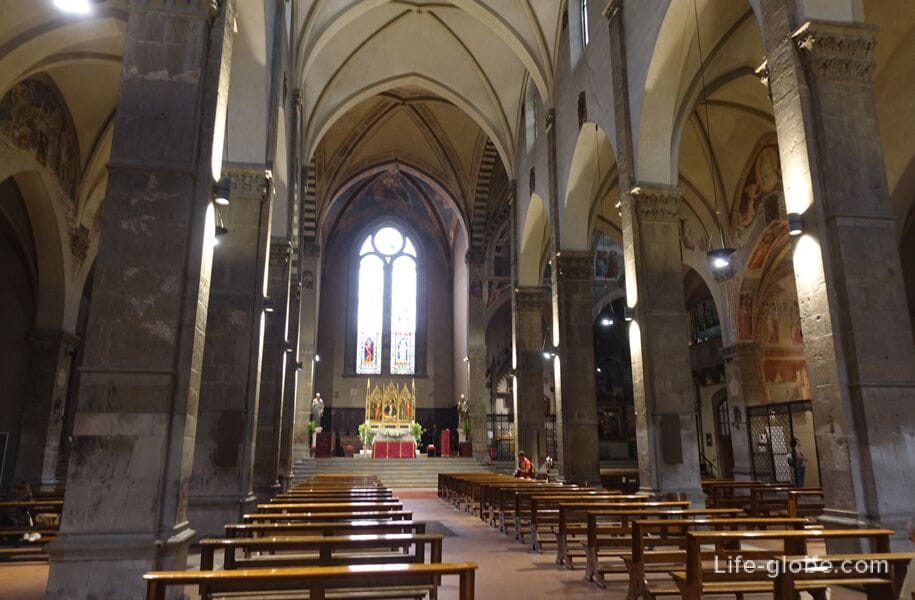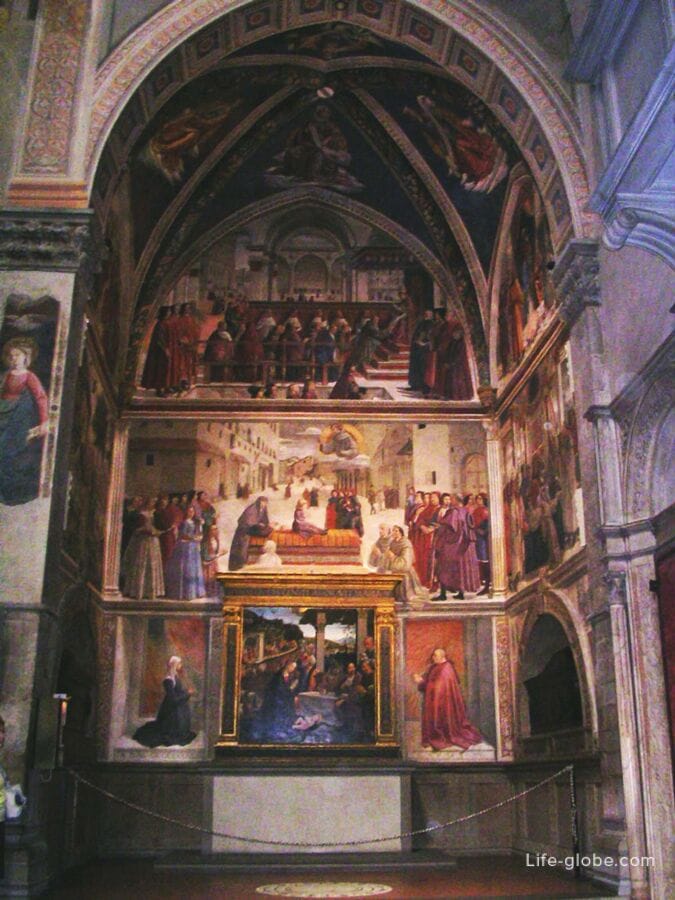
The Basilica of Santa Trinita or Basilica of the Holy Trinity (Basilica di Santa Trinita) is a Roman Catholic church in Florence with chapels with frescoes from the 15th century, which are considered masterpieces by Italian artists Domenico Ghirlandaio and Lorenzo Monaco.
Santa Trinita has the status of a minor basilica and is one of the most important basilicas in the historical and artistic evolution of the city of Florence, which for 8 centuries belonged to the monastic order of the Vallombrosans.
The Basilica is located in the historical center of Florence, on the western side of the eponymous Piazza Santa Trinita, next to the Column of Justice (Colonna della Giustizia) and several palaces.

The Basilica of the Holy Trinity was erected on the site of an earlier Romanesque church, documented as early as 1077 and dedicated to Santa Maria dello Spasimo. Traces of this Romanesque shrine are preserved on the counterfacade, in the underground crypt (columns of green marble, which in ancient times stood on bases of white marble), as well as on some inscriptions and tombstones of the basilica.
Between 1250 and 1258, work began on the expansion of the Gothic-style church according to a project attributed to Nicola Pisano, but most likely the project belonged to Neri di Fioravanti. It was one of the first Gothic churches in Florence.
Over time, the church expanded, and it was decorated, including frescoes. On the main altar there was a tempera on wood of the Majesty of Santa Trinita (or Madonna di Santa Trinita) by the Italian artist Cimabue, painted between 1280 and 1300, and which today is in the Uffizi Gallery in Florence.
At the end of the sixteenth century, as part of the reconstruction after the Counter-Reformation, which the Medici Grand Dukes promoted in Florentine churches, the inhabitants of Vallombrosa asked Bernardo Buontalenti to repair the presbytery of the church of Santa Trinita and rebuild the monastery. Thus, the complex has acquired a strict and at the same time impressive style. Buontalenti, having dismantled the monastic choir, created an artificial monumental altar with an original staircase (1574), located today in the church of Santo Stefano al Ponte (Chiesa di Santo Stefano al Ponte) in Florence.
During the French occupation in the 19th century, attempts were made to change the basilica; also, some works from the Church of San Pancrazio (Chiesa di San Pancrazio) in Florence, now deprived of consecration and where the Museum of Marino Marini (Museo Marino Marini) is located, among them: a large free-standing fresco with San Giovanni, were transferred to it Gualberto enthroned, the Saints and Blessed of Vallombrosani by Neri di Bicci (1455) and the tomb of Benozzo Federighi by Luca della Robbia, now in the left transept.
During the restoration in the 20th century, carried out after the flood of 1966, the church acquired its appearance until the 19th century.
Today, the facade of the Basilica of Santa Trinita is a typical work of Florentine late Mannerism, characterized by a symmetrical geometric pattern with traditional elements.
The main facade of the church is divided into three zones by pilasters. The central part at the top has a large pediment with a round window. A three-dimensional high relief of the Trinity is placed above the central door. On the left in the niche there is a statue of SantAlessio, which, like the relief of the Trinity, is by Giovanni Battista Caccini (1594). The wooden doors of the basilica date back to 1640.

Inside, the basilica has a T-shape typical of the monastic orders of that time, with a square apse illuminated by a long mullioned window.
The basilica has three naves, separated by rectangular columns with arched ceilings. Cross vaults.
The main altar is the result of combining several parts from different sources, including the frontal with the Trinity attributed to Agostino di Duccio, and columns from the workshop of Desiderio da Settignano. The triptych of the Trinity by Mariotto di Nardo (1416) was commissioned by Niccolo Davanzati and comes from the deposits of the Accademia Gallery in Florence.

Along the aisles and on the main side of the transept are chapels with frescoes and other works of art.
The most famous of the chapels are:
- Sassetti Chapel with 15th-century frescoes of the History of St. Francis, which are considered a masterpiece by Domenico Ghirlandaio;

- The chapel of Bartolini Salimbeni with frescoes by Lorenzo Monaco, dating from the 1420s, and which are among the few surviving examples of international Gothic frescoes in Italy. The chapel has also preserved other original elements, such as the altar, the Annunciation, also by Monaco, and the railing.

On the Romanesque counterfacade there are various inclined fragments, including a fresco depicting the Trinity of the early fifteenth century, the tombstone of the abbots of San Pancrazio (fourteenth century) and, on the left, the tombstone of Giovanni di Antonio Amati, attributed to Antonio del Pollaiolo.

There is a crypt in the basilica.

Along Via del Parione, on the right side of the church, there is a building of the former monastery, which today houses organizations. At number 7 there is an entrance to the monastery, built by Alfonso Parigi the Elder, designed by Bernardo Buontalenti between 1584 and 1593. It has a courtyard with arcades on four sides and is raised above street level; round arches of cross vaults are placed on large columns with Doric capitals; in the center of the courtyard is a well surrounded by flower beds.
Frescoes by Giovanni da San Giovanni, Nicodemo Ferrucci and Jacopo Confortini depicting the Madonna in Glory, greeted by the Trinity, and scenes from evangelical boarding schools dating from 1630-1632 are preserved in the former refectory of the monastery.

Entrance to the Basilica of Santa Trinita is free.
The address of the Basilica of Santa Trinita: Piazza di Santa Trinita, 50123 Firenze FI, Italy.
Coordinates of the Basilica of Santa Trinita: 43°46'12.6"N 11°15'02.4"E (43.770178, 11.250667).
All accommodation facilities in Florence (hotels, apartments, guest houses, etc.), including in the historical center of the city and more remotely from it, can be viewed and booked here